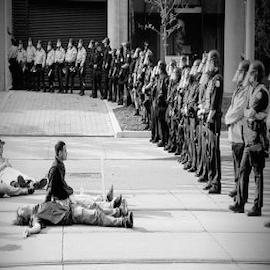Canada is currently undergoing a human rights crisis. The Liberal government is currently conducting public consultations over the “problematic elements” of the so-called anti-terror Bill C-51. However, this process is already set up to be rigged.
This three-part blog series will act as a response to the Liberal government’s rhetoric of amendments by highlighting the actual problematic elements of the Act. Ultimately, the Liberal government should repeal and replace the Act with national security measures that can be held accountable to our Charter rights to democratic participation, and privacy.
This series is meant to inform activists and concerned citizens about the dangers of unshackled national security law in a time where an atmosphere of fear overshadows our democratic rights.
Bill C-51, or the Anti-Terrorism Act (2015), is not the beginning of the atmosphere of fear and anxiety around national security in Canada. This act is connected to a larger history of domestic espionage that came to explicitly target activists as national security threats.
This history is a difficult one to piece together because of its cryptic nature. As Jeffery Monaghan illustrated, the expansion of Canada’s national security apparatus really picked up after the terrorist attack on 9/11. This, compounded with several mega-events like the Vancouver Olympics and the Toronto G20 Meetings, led to the development of Canadian intelligence “fusion centres” meant to transform multiple agencies into one intelligence behemoth.
A fusion centre is a multi-organizational unit that centralizes the collection and dissemination of intelligence that is than fed back into the various departments responsible for policing. In Canada, this is called the Integrated Terrorism Assessment Centre (ITAC) under the guidance of Canadian Security Intelligence Service (CSIS). There are similar ones throughout the Five-Eyes Nations.
Fusion centres collect intelligence from meta-data, message content and various Internet sources. The reliability of this data can vary. And from this variance, police are often given information that represents stereotyped tropes of the characters that they need to keep an eye out for.
In the wake of 2010’s mega-events, the ITAC constructed a new category of national security risk called Multi-Issue Extremism (MIE). This essentially led to the blurring of extremism and activism. As a result, environmentalists, Indigenous activists and anti-capitalists became groups of suspicion and risk.
“Only when CSIS and the ITAC became the ‘fusion centre’ of Canada’s intelligence community,” Monaghan writes, “did the threat assessments begin to shift from abstract, distant terrorist threats towards tangible and imminent subjects of insecurity and dissent.”
This is still the case today. The CSIS website includes anti-capitalism as a dangerous threat to Canadian security. They write, “Grievances harboured by those who oppose issues such as the perceived dehumanizing effects of capitalism are likely to continue and may trigger additional acts of serious violence.”
There have been no major cases of extreme violence from anti-capitalists in recent history. Despite this, MIEs include the category of left-wing extremism that the RCMP describe as, “a vast political movement sharing a number of beliefs that reject capitalism, Western democracy as we know it, imperialism and militarism.” This list of dangerous entities includes the notorious hacking group Anonymous and the very fluid category of anarchism.
Domestic spying on groups that oppose the state, particularly in terms of resource extraction, are likely to be more common than we think. Amidst the debates around Bill C-51, CSIS was caught briefing government officials on how to police environmental and Indigenous pipeline activists.
Though there is no way to find the depth of CSIS’s involvement in domestic investigations, the threat is real. Even ATIA requests are often redacted, intentionally delayed or despairingly vague. This allows Public Safety Canada to cover its tracks, keeping the curtain drawn on CSIS’s cryptic actions.
Until 2015, the CSIS Act legislated that the spy agency was not able to conduct any physical or kinetic investigations. In effect, CSIS was only allowed to collect intelligence data — not interfere with any individual or group. Bill C-51 changes that. It empowers the spy agency to take action to “reduce threats” to the security of Canada. This can include disruption and sabotage. It also includes the ability to request warrants to violate Charter rights through a secret court under the shadow of confidentiality.
The only restrictions to this are that CSIS can’t cause harm, sexually abuse anyone, or interfere with police investigations. When held in historical context, the results are terrifying. CSIS now has expanded powers to explicitly target groups they have already been exposing to surveillance.
It is clear that the ITAC equates political opposition to Canada’s involvement in resource extraction and settler-colonial expansion with extremist views that threaten public safety and security. This isn’t a fight against terror — it is the strong arm of the state protecting the interests of capital.
Part two of this series will look at the threats to internationally recognized human rights that this Act imposes on Canadians. And part three will look at the problematic elements of the consultation process itself and why it appears to be a stalling technique.
Please chip in to keep stories like these coming.
Image: Flickr/Joshua Scott



